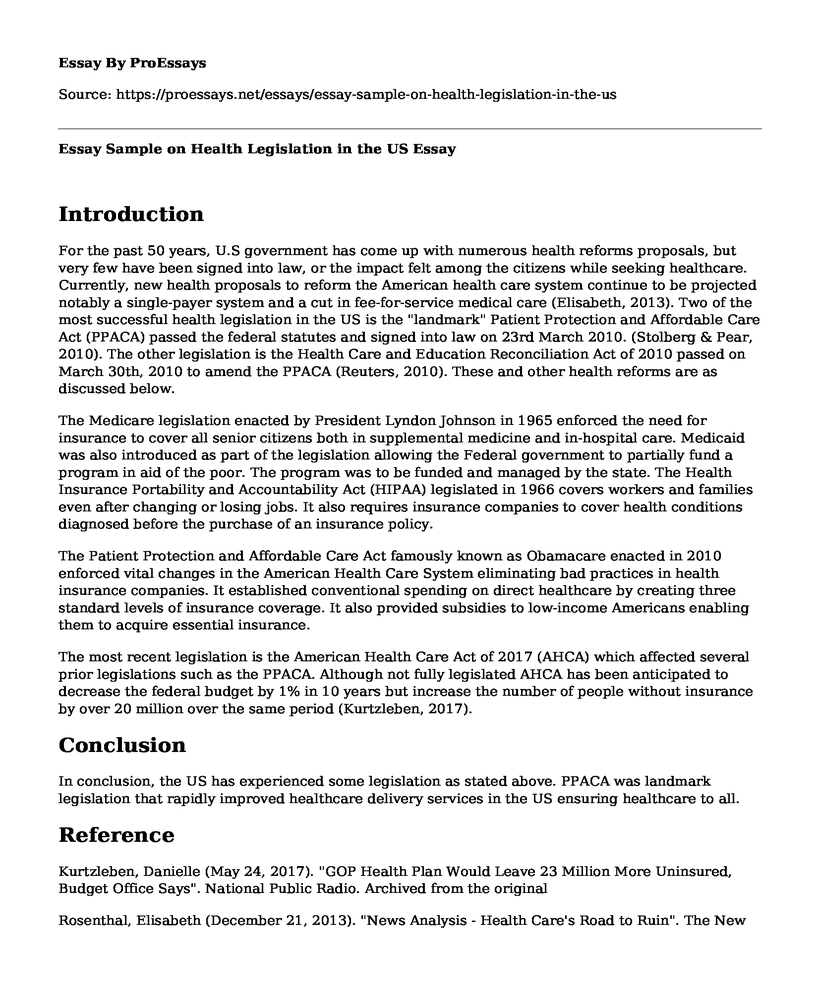Introduction
For the past 50 years, U.S government has come up with numerous health reforms proposals, but very few have been signed into law, or the impact felt among the citizens while seeking healthcare. Currently, new health proposals to reform the American health care system continue to be projected notably a single-payer system and a cut in fee-for-service medical care (Elisabeth, 2013). Two of the most successful health legislation in the US is the "landmark" Patient Protection and Affordable Care Act (PPACA) passed the federal statutes and signed into law on 23rd March 2010. (Stolberg & Pear, 2010). The other legislation is the Health Care and Education Reconciliation Act of 2010 passed on March 30th, 2010 to amend the PPACA (Reuters, 2010). These and other health reforms are as discussed below.
The Medicare legislation enacted by President Lyndon Johnson in 1965 enforced the need for insurance to cover all senior citizens both in supplemental medicine and in-hospital care. Medicaid was also introduced as part of the legislation allowing the Federal government to partially fund a program in aid of the poor. The program was to be funded and managed by the state. The Health Insurance Portability and Accountability Act (HIPAA) legislated in 1966 covers workers and families even after changing or losing jobs. It also requires insurance companies to cover health conditions diagnosed before the purchase of an insurance policy.
The Patient Protection and Affordable Care Act famously known as Obamacare enacted in 2010 enforced vital changes in the American Health Care System eliminating bad practices in health insurance companies. It established conventional spending on direct healthcare by creating three standard levels of insurance coverage. It also provided subsidies to low-income Americans enabling them to acquire essential insurance.
The most recent legislation is the American Health Care Act of 2017 (AHCA) which affected several prior legislations such as the PPACA. Although not fully legislated AHCA has been anticipated to decrease the federal budget by 1% in 10 years but increase the number of people without insurance by over 20 million over the same period (Kurtzleben, 2017).
Conclusion
In conclusion, the US has experienced some legislation as stated above. PPACA was landmark legislation that rapidly improved healthcare delivery services in the US ensuring healthcare to all.
Reference
Kurtzleben, Danielle (May 24, 2017). "GOP Health Plan Would Leave 23 Million More Uninsured, Budget Office Says". National Public Radio. Archived from the original
Rosenthal, Elisabeth (December 21, 2013). "News Analysis - Health Care's Road to Ruin". The New York Times. Retrieved December 22, 2013.
Sheryl Gay Stolberg and Robert Pear. (2010, March 23). Obama Signs Health Care Overhaul. Into Law. Retrieved March 26, 2018, from https://www.nytimes.com/2010/03/24/health/policy/24health.htmlon March 26, 2018
Reuters. (2010, March 19). FACTBOX-US healthcare bill would provide immediate benefits. Retrieved March 26, 2018, from https://www.reuters.com/article/usa-healthcare-timeline/factbox-us-healthcare-bill-would-provide-immediate-benefits-idUSN1914020220100319
Cite this page
Essay Sample on Health Legislation in the US. (2022, Apr 14). Retrieved from https://proessays.net/essays/essay-sample-on-health-legislation-in-the-us
If you are the original author of this essay and no longer wish to have it published on the ProEssays website, please click below to request its removal:
- Hospital Management Strategies by Ronald A. Nykiel
- Patient Testimony: Motor Vehicle Accident
- Clinical Placement Reflection
- Tuberculosis Epidemic in Texas Paper Example
- Avoiding Outdoor Activities in Polluted Areas Paper Example
- A Report for the Community Health Assessment Plan
- Early Life Probiotics for Improving Postnatal Outcomes - Research Paper







